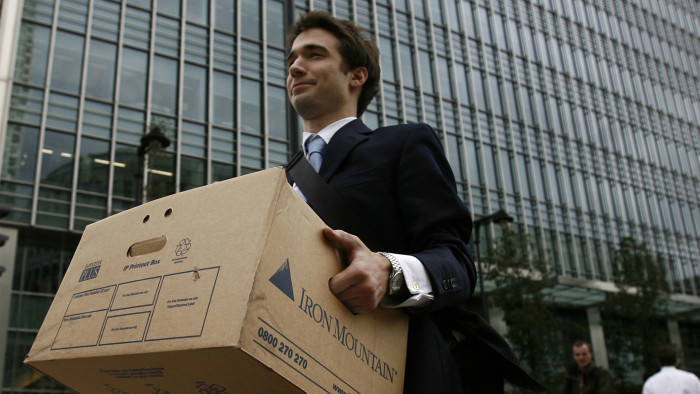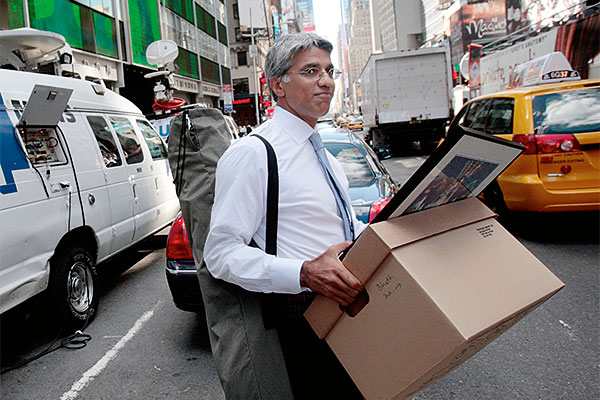What Lehman Brothers staff did next

Roula Khalaf, Editor of the FT, selects her favourite stories in this weekly newsletter.
“Lehman Brothers is not afraid of risks. The biggest risk sometimes is to take no risk at all.” So said Robert Lehman, who for many decades ran the company that his father had founded in 1850 as a cotton trading operation but grew to become the fourth-largest investment bank on Wall Street.
Lehman junior might just as easily have been referring to the attitude of dozens of former Lehman employees, who have gone on successfully to set up their own businesses following its bankruptcy in 2008 at the nadir of the financial crisis.
Mass layoffs and market chaos followed the now infamous collapse of Lehman, which triggered the worst banking crisis the world had experienced for almost 80 years. Investors’ money was wiped out. From what remained, Barclays bought Lehman’s US investment banking and trading business, while Nomura acquired the company’s European and Asian franchises. However, many of Lehman’s top people who had already left in the bank’s final years or in the aftermath of its collapse decided to strike out on their own.
The result is the dawn of a generation of entrepreneurs who have risen from the carnage. These include former Lehman executives who have founded private equity firms JRJ Group and Trilantic Capital Partners, corporate finance boutiques Ondra Partners and Noah Advisors, and a swath of other businesses outside finance.
Lehman is not alone in producing entrepreneurs among the bulge-bracket banks, which share a culture of long hours and competitiveness with the start-up scene. The new companies that grew out of Lehman’s bankruptcy were part of a bigger wave of people from financial services who set up their own businesses, perhaps disillusioned with the established system. It was partly out of necessity — thousands of people lost their jobs, but many had the financial security of bonuses from the bull market years to support them in a change of direction.
But living through the boom and the crash at the bank made many reconsider their careers. Others, however, left the company earlier to forge ahead on their own.
Britt Lintner, a managing director at Deutsche Bank Asset Management who previously worked at Lehman for eight years says that the “Lehman’s bankruptcy was an epiphany”. After she left in 2003, Lintner set up a women’s clothing business. She adds: “There was a loss of trust and faith in the banking system and people felt it was their chance to do something different.”
Yet it does feel as if there was something different about how Lehman was managed. So what was it about the now-defunct US bank that made it such an incubator for budding entrepreneurs?
Former Lehman employees point to a entrepreneurial culture at the bank, particularly in Europe, that they believe prepared and encouraged them to strike out on their own.
That culture had deep roots. As a commodities trading and brokerage operation, Lehman thrived during the economic and industrial expansion in the US in the second half of the 19th century, before moving into investment banking in the early days of the new century. In his 1966 book, The Merchant Bankers, Joseph Wechsberg wrote that the House of Lehman’s operations “are characterised by ‘ingenuity’ . . . They are a bunch of brilliant entrepreneurs, unorthodox without being unconservative.”
Long before the financial crisis, the company’s executives had begun breaking out. Lehman dealmakers Pete Peterson and Stephen Schwarzman founded Blackstone Group, now the biggest private equity company in the world, and Evercore, one of the largest independent investment banks in the US, was set up by Roger Altman, a protégé of Peterson at Lehman and Blackstone.
In 1984, Lehman Brothers was acquired by American Express and merged with its retail brokerage Shearson to form Shearson Lehman Brothers. American Express began to divest its financial services by business lines, and in 1993 the bank was spun off and once again became known solely as Lehman Brothers.
Dick Fuld, Lehman’s chief executive from 1994 until its bankruptcy, hired Jeremy Isaacs and Roger Nagioff (the duo who later set up JRJ) with a mandate to expand the bank’s operations in Europe and Asia from a small office at 1 Broadgate next to London’s Liverpool Street station. “The two were very dynamic guys who set the tone for Europe,” recalls one person who worked for them. “They made it the entrepreneurial, street-fighting, chip-on-the-shoulder organisation that it was.”
It was a company on the make. “For those who joined Lehman Brothers in the early 2000s you went there to build,” recalls John Candillier, a Lehman managing director between 2002 and 2008. “Your mandate was to build, hire, create. There was no script on how to do that. You wrote it along the way by working relentlessly at disrupting the status quo.”

Candillier co-founded and is now chief executive of the Keyfetch Group, an online “lost and found” service that uses technology to help people protect their valuables.
While larger names that were better established in Europe were constrained by their long-term strategies, Lehman had the luxury of being nimbler. “Lehman Brothers was a firm that didn’t focus on big plans or strategies,” says Adrian Valenzuela, who founded Hong Kong-based brokerage MCM Partners in 2012 with Rachid Bouzouba, the bank’s former head of equities for Europe, the Middle East and Africa. “It didn’t behave like a bulge-bracket firm or a premier franchise. This gave it the liberty to be more opportunistic and reactive.”
Some factors that led to the bank’s eventual downfall — creative attitudes towards funding, not enough checks and balances — also created a fertile environment for new concepts to flourish.
“It was a place where ideas would travel very rapidly,” says Vittorio Pignatti-Morano, who ran Lehman’s private equity business for Europe and the Middle East, and set up Trilantic afterwards with two partners and a team from the bank. “The investment committee wouldn’t a priori say it’s a wild idea only because they’d never heard of it. You were right until you were proven wrong.”
There was little hierarchy. “Even at a junior level you got lots of responsibility,” says Gustave Geisendorf, who spent almost a decade at Lehman before founding Nova Investment Partners, a Nordic-focused venture capital company. “At other banks there are clear definitions of what an associate, vice-president, managing director is supposed to do. At Lehman there were no such boundaries; the only limits were your abilities and your commitment.”
The US bank’s status as the underdog in Europe meant it had to fight harder to prove itself. “At Lehman in Europe the investment bankers and capital markets individuals were better than the brand,” says Benoit D’Angelin, the bank’s former co-head of European investment banking. “They had to be better — more competitive, creative and entrepreneurial. It was not the case at some other top investment banks where the brand was better than the bankers.”
Jorn Werdelin, a former mergers and acquisitions banker at Lehman who went on to set up Linde Werdelin, a maker of luxury sports watches, agrees: “At Lehman Brothers we weren’t necessarily the number one choice for a CEO. That gives you a certain fighting instinct that you’re less likely to have coming out of Goldman Sachs or Morgan Stanley.”
Career paths could be unconventional and people were encouraged to move between divisions and countries. That environment meant Lehman built more rounded managers as well as entrepreneurs. For example, Xavier Rolet, who is now chief executive of London Stock Exchange Group, was co-head of global equity trading at the bank in London, led a newly created European senior client relationship management group and was chief executive of Lehman in France.
Former employees recall that their peers were frequently trying to raise money for ventures set up by their friends and family. One such fledgling project around the turn of the millennium was Net-a-Porter, a website for selling designer fashion founded by Natalie Massenet that has gone on to be one of the internet’s great success stories. Her then husband, Arnaud Massenet, ran equity derivatives at Lehman in Europe and helped raise the roughly £1.5m of seed capital from his colleagues.
People were brought in to build businesses and left to get on with it. In 1995, Lehman hired Noam Gottesman, Pierre Lagrange and Jonathan Green from Goldman Sachs’ private client division to start a hedge fund business, GLG Partners, as a unit of the bank. By the time GLG — which is now owned by Man Group — was spun off five years later, its initial team of 13 people had grown to around 150.
After Lehman, D’Angelin set up Ondra, an advisory boutique, with Michael Tory, who had run UK investment banking. Tory had joined Lehman from Morgan Stanley, drawn to the challenge of working for an up and coming company. He reckons that the bank attracted a certain type of person: “Lehman was always — both in the US and especially in Europe — the scrappy insurgent. It was fighting to come up from a lower base. It had to try harder. The people who were drawn to Lehman were themselves more entrepreneurial — and therefore more likely to do something entrepreneurial afterwards.”
Two-way street: start-ups not for all

The day Lehman Brothers filed for bankruptcy, September 15 2008, was one Lynn Gray had anticipated for more than a year, writes Anna Nicolaou in New York. The company’s former chief administrative officer had been looking for opportunities outside the company when layoffs raised the spectre of an implosion. But she describes the day as “very, very sad” even if it was not a surprise.
“People were just crying. We had lived as the underdog for so long. Lehman had such a special culture; we were survivors,” she says.
It was this culture, and the dire job market, that spurred Gray to start a company, rather than joining another bank after her role became redundant in the takeover by Barclays. “Lehman was different to the rest of Wall Street,” she says. “It was more collegial and less rigid because it was smaller, so you could do creative things.”
With job opportunities slim, and having a 10-month severance package, she says she “wasn’t going to put her CV on [job-search site] Indeed.com”.
Gray started teaching at New York University, which sparked an idea for a recruitment service for companies that did not have the formal strategies for hiring on university campuses that the banks did. She has run the company since 2009.
But Gray says she was the exception rather than the rule and the vast majority of her Lehman colleagues from New York have gone back into banking and finance. Even now, eight years after the crisis, more than 60 per cent of workers who leave banking remain in the financial services sector, according to an analysis of 24,500 people carried out by networking site LinkedIn for the Financial Times last year.
Brad Hintz, who had been chief financial officer of Lehman in the late 1990s, says there were striking differences between Lehman’s US and European arms, which might explain why fewer New York alumni have become entrepreneurs.
The divergence stretched back to the 1980s, when Lehman “fought a civil war” between bankers and traders, leading to a sale of the company to American Express. The Amex acquisition was a “disaster” for Lehman, Hintz says, and years of underinvestment and disappointing profits eventually led to a spin-off.
Lehman’s senior management, led by Dick Fuld and Chris Pettit, who had been in post throughout the period of Amex ownership, were based in New York and aimed to revive the company, which had fallen behind its peers in the derivatives and high-yield businesses.
“From these events, a New York Lehman culture was born — it was a company driven to succeed, which always felt like an outsider, with a chip on its corporate shoulder,” says Hintz. Lehman in New York had a “sharper edge to it” because of the company’s history and the New York office was “much harder to deal with” than the London operation, which was more “grey flannel”, he says. In New York, Hintz felt like he “needed a whip and chair when I went down to the fixed income trading floor”.
Lehman’s European arm was smaller and Europe’s economy took longer to recover than that of the US, which might explain why Lehman’s London staff were more likely to start companies than work in a bank, he says.
“Wall Street recovered and then you saw a boom in fixed income markets, and mergers and acquisitions coming back.
So you were in better shape as an unemployed Lehman employee looking for a new job in New York than in Europe. That leads to entrepreneurial decisions [in Europe] out of necessity,” he says.
Comments